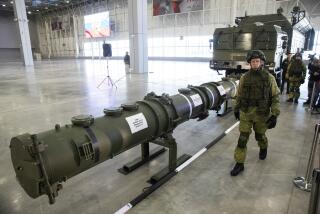‘Star Wars’ Pushed Soviets to Bargaining Table, Reagan Says
WASHINGTON — President Reagan, marking the fourth anniversary of his proposal to develop a “Star Wars” missile defense system, said Monday that the project “has been a singularly effective instrument for bringing the Soviets to the bargaining table.”
Reagan said that “remarkable progress” has been made by scientists and others working on the Strategic Defense Initiative, the formal name for the space-based missile defense program. “One thing is clear: SDI truly serves the purposes of offensive weapons reduction,” the President said in a written statement.
The President, facing some congressional opposition to “Star Wars” funding and Soviet insistence that the program be a central element in its overall arms control bargaining, has shown no inclination to back away from his advocacy of the project, which he unveiled March 23, 1983.
“Like an effectively verifiable arms reduction agreement with which all parties comply, SDI can reduce the risk of war and the threat of ballistic missiles to mankind,” he said.
Meanwhile, the Administration rejected as “patently false” a Soviet charge that it is blocking progress toward eliminating medium-range nuclear weapons from Europe but repeated its demand that any formal agreement cover shorter-range missiles as well as the longer-range intermediate systems that have received most attention so far.
These shorter-range missiles promise to be one of the major obstacles to a new agreement. On Sunday, Viktor P. Karpov, the chief Soviet arms control official, accused the United States of raising the issue in an effort to scuttle the negotiations on the longer-range weapons.
White House spokesman Marlin Fitzwater said the Administration remains optimistic that the United States and the Soviet Union will be able to reach an agreement to reduce intermediate-range nuclear missiles.
“The Soviets have expressed reservations and doubts and so forth. But it’s all a fairly standard part of their public posture during negotiations of this kind,” he told reporters.
The U.S.-Soviet exchange of words on the shorter-range missiles was viewed as preliminary sparring leading up to Secretary of State George P. Shultz’s visit to Moscow in mid-April, when serious bargaining is anticipated on an agreement to limit intermediate nuclear forces.
Neither side has reached a precise and firm position on the shorter-range issue, a senior U.S. official said. West Germany and Britain have not told the United States what outcome they seek from negotiations on these missiles, which threaten their forces primarily. The Kremlin has advanced three positions on the issue, which may represent bureaucratic infighting in Moscow, the U.S. official said.
State Department spokesman Charles Redman recalled Monday that the United States has introduced a draft treaty at the Geneva arms talks that would eliminate intermediate-range missiles (which can hit targets 1,000 to 3,000 miles away) and limit each side to 100 warheads of this type worldwide. “We are ready to conclude an agreement on that basis as soon as possible,” he said.
However, the United States has insisted since the start of the negotiations in 1981 that the short-range missiles (of 500 to 1,000 miles) also be restrained, he said. Otherwise, they could be repositioned to substitute for the longer-range systems.
The latest U.S. offer calls for “equal U.S. and Soviet rights” to the shorter-range weapons “at the current Soviet level or lower,” Redman said. Moscow has 140 such weapons, compared to none for the United States. The Soviets want to freeze these missiles at their current level, which would perpetuate the Soviet monopoly.
“The United States will continue to insist that appropriate equal constraints on shorter-range . . . missiles be an integral element of an initial INF treaty,” Redman added. U.S. officials have said that the United States wants at least to write the principle of equality into the treaty before it is signed but would be willing to negotiate a precise ceiling on the weapons later.
Karpov complained that the U.S. proposal would permit the conversion of U.S. Pershing 2 missiles from their present intermediate range to short range by eliminating the second of its three stages.
The weapon could be quickly reconstituted into a prohibited missile, he said, although presumably the Soviet SS-20 intermediate-range missile could be similarly modified and be similarly capable of rapid upgrading.
More to Read
Sign up for Essential California
The most important California stories and recommendations in your inbox every morning.
You may occasionally receive promotional content from the Los Angeles Times.










